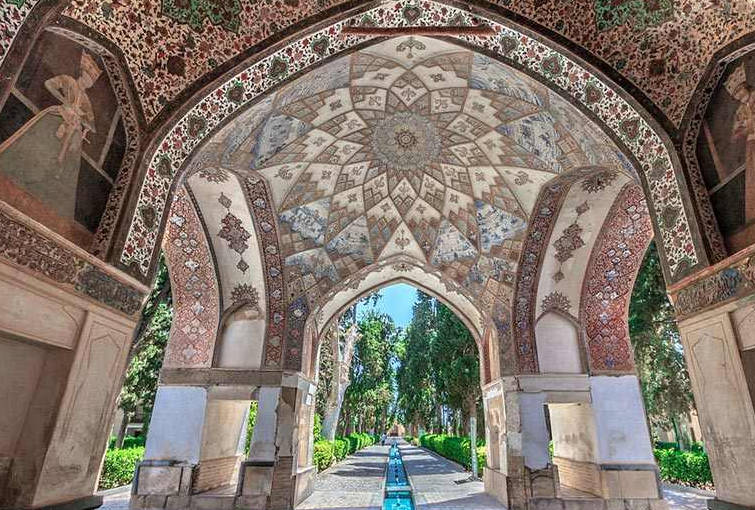Fin Garden : what you know about it + video
Fin Garden : An Oasis of Persian Aesthetics and Design : Stepping into the city of Kashan, Iran, one cannot help but be struck by its rich tapestry of history, culture, and architecture. Among the many treasures that this ancient city holds, the Fin Garden, or “Bagh-e Fin”, stands as a magnificent testament to Persian landscape design and aesthetics. A UNESCO World Heritage site, the garden is not only a representation of Persian garden design but also a symbol of the unique blend of art, architecture, and natural elements in Iranian culture.
Watch the video:
History and Background
The history of Fin Garden traces back to the Safavid dynasty, though its current layout and design owe much to the Qajar era. The Safavids, who ruled Iran from the 16th to 18th centuries, were instrumental in developing the concept and aesthetic of the Persian garden, which became a vital part of the urban and rural Iranian landscapes. Bagh-e Fin, during its nascent stages, became a residence for Safavid kings on their visits to Kashan.
Fin Garden, Kashan, Iran (4k) :
However, the garden is not merely known for its breathtaking beauty but also for its poignant historical significance. One of the darker chapters in Iranian history occurred within the confines of this paradise when Amir Kabir, a Qajarid chancellor, was murdered under the orders of King Nasereddin Shah. This act, which took place in the garden’s bathhouse, added an indelible mark to the garden’s history.
Fin Garden : An Oasis of Persian Aesthetics and Design
Concept of Persian Gardens
To understand the significance and design of Fin Garden, one needs to delve into the concept of Persian gardens. The gardens, known as “paradise gardens”, are typically enclosed spaces symbolizing the Edenic, heavenly paradise described in ancient Persian scriptures and the Quran. The word “paradise”, in fact, originates from the Old Persian word “pairidaeza”, meaning “walled-around” or “enclosed space”.
The design of these gardens is primarily characterized by a quadripartite layout, known as “chahar bagh”. This layout divides the garden into four distinct parts, usually by water channels or pathways. Water, a vital element of these gardens, symbolizes life and vitality, especially significant given Iran’s arid climate. The flow of water through the gardens is a testimony to the Persian ingenuity in engineering and their profound respect for nature’s resources.

Design and Architecture of Fin Garden
Fin Garden, spread across 2.3 hectares, exemplifies the quintessential chahar bagh layout. Enclosed by walls, it houses numerous buildings, pathways, and water channels. The integration of built structures with natural elements is done seamlessly, reflecting the Persian ethos of balance and harmony.
The central feature of the garden is its water system, sourced from the Sulaimaniyah spring. This water is ingeniously channeled through a series of pools and fountains, providing both aesthetic and functional value. The turquoise-tiled pools, combined with the sound of flowing water, bring a refreshing coolness to the environment, crucial in the arid climate of Kashan.
Flanking these water channels are the garden’s lush plantations. Tall trees, including the iconic cypress and fruit-bearing ones like pomegranates and cherries, offer shade and sustenance. These trees not only enhance the visual appeal but also play a pivotal role in regulating the garden’s microclimate.

Interspersed among the verdant expanse are architectural marvels that echo the splendors of Persian craftsmanship. The central pavilion, or Kushak, stands elevated, providing panoramic views of the garden. Its walls and ceilings are adorned with intricate stucco work and colorful frescoes, typical of Persian royal architecture. Not to be missed is the garden’s bathhouse, which, despite its somber history, is an architectural gem with its turquoise and gold tiles, archways, and ornate plasterwork.
Role in Cultural and Social Life
The design of Persian gardens, including Fin, is not just an aesthetic endeavor. These spaces are deeply rooted in the cultural, spiritual, and social fabric of Iranian society. Gardens were often places of leisure and literary pursuits for the royalty and nobility. Poetry sessions, musical soirees, and intellectual debates would be hosted under the shade of the trees, by the side of gurgling fountains.
Furthermore, the design of these gardens often carried spiritual and cosmic connotations. The quadripartite layout is said to represent the four Zoroastrian elements of sky, earth, water, and plants. The flowing water symbolizes the stream of life and the eternal journey of the soul. Thus, walking in the Fin Garden becomes a meditative experience, where nature, art, and spirituality coalesce.
Fin Garden in Modern Times
In the contemporary era, the Fin Garden continues to be a beacon of Persian culture and heritage. Its preservation as a UNESCO World Heritage site ensures that it remains an authentic representation of its historic self. For travelers and scholars, the garden serves as a live museum, offering insights into Persian history, architecture, and philosophy.
Local residents of Kashan, too, find solace and pride in this garden. Many families frequent the garden for picnics, drawing inspiration from the age-old traditions of leisurely garden visits. The younger generation, amidst the cypress trees and flowing channels, is reminded of their rich heritage, ensuring that the stories and significance of places like Fin Garden are carried forward.
In the cacophony of the modern world, spaces like Fin Garden are essential. They not only offer a visual and sensory respite but also remind us of the delicate balance between nature, art, and humanity that ancient cultures championed. In the heart of Kashan, the garden stands as a testament to the timelessness of Persian aesthetics and the universal human yearning for beauty, peace, and harmony.


